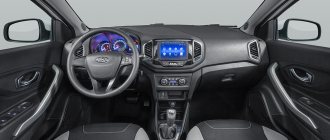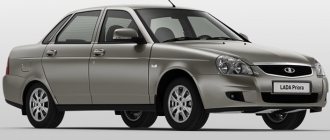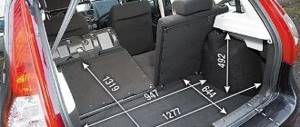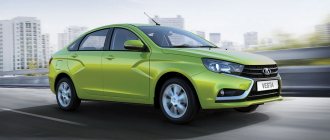The Lada Priora was initially produced in four body styles: station wagon, sedan and hatchback (including a hatchback coupe). However, which is quite obvious, only two body types have the greatest viability: a sedan and a hatchback, since the station wagon is not of such consumer interest, and at the moment Priors with such a body are no longer produced. By the way, VAZ was going to produce the Priora as a convertible, but this idea was abandoned because In our country this car simply will not find a buyer. But sedans and hatchbacks are the most popular options, and eternal competitors in attracting buyers, who periodically pull the rope of sales leadership, depending on fashion trends, car class, brand, practical and aesthetic ideas of consumers. Now we will try to figure out what features and advantages the Lada Priora with a hatchback body has in a five- and three-door (compartment) version.
Engines on Lada Priore hatchback
The 5-door hatchback VAZ 2172, produced since 2007, is equipped with three engines with different rated power, volume 1596 cc:
- Eight-valve 81-horsepower engine with a maximum speed of 172 km/h with a fuel consumption of 7.6 liters per 100 km. when driving in mixed mode. This is the least economical of all Priora engines, although it is the cheapest. Currently, Priors are no longer equipped with it;
- 16-valve, 89-horsepower, capable of accelerating the car to 176 km/h. Fuel consumption in the combined cycle is slightly lower, namely 7.3 l/100 km;
- 98 horsepower: this 16-valve engine accelerated the hatchback to 183 km/h and consumed 7.4 l/100 km in the combined cycle; Until 2013, the 3-door hatchback coupe was equipped with only one engine – 98 l/s, which gave this car the same technical characteristics as its 5-door brother.
External and internal view of Lada Priora
New Priors are now equipped with Euro handles from the factory. In our opinion, this is a small plus for design and convenience. You will not receive fog lights in the basic configuration; they are equipped with Priora luxury versions , which are already much more expensive. The trunk opens conveniently, its volume is 360 liters, which is not a bad indicator for a hatchback. With the rear seats folded down, the volume of the compartment increases to 700 liters, so transporting any large cargo should not cause problems.
Let's move on to the interior. The Priora's interior is the most modern of domestic cars. The seats are comfortable and have a sufficient number of adjustments. There is enough space for three in the back; only a tall passenger can reach his head to the ceiling, and his knees will rest against the back of the front seat only if it is pushed back to its fullest position. The door trim and front panel are made of dark gray plastic, the quality of which is much better than that of previous VAZ models. The instrument cluster is traditional and convenient, so we won’t focus much attention on it. The controls are convenient and did not cause us any complaints; everything is quite simple, and anyone can understand them. When driving, there is a lot of extraneous noise in the cabin, therefore, as we already noted in the article about the VAZ 2115, additional sound insulation will not hurt.
Photo of Lada Priora hatchback interior – Dashboard
Photo of Lada Priora hatchback interior – Dashboard
Engine Priora Hatchback after restyling 2013
In 2013, the creators of the Priora decided to update its design, improve ergonomics and retrofit the car according to the requirements of the time, as a result of which the 81-horsepower and 89-horsepower engines were removed from the package. Instead, new 16-valve engines are installed, albeit of the same volume:
- at 98 l/s, giving a maximum speed of 183 km/h, acceleration to “hundreds” in 11.5 seconds, and consuming 6.9 liters of fuel per 100 km;
- 106-horsepower, which has the same speed characteristics, but slightly reduces fuel consumption (up to 6.8 liters of AI-95).
Trunk volume of Lada Priora hatchback: size and characteristics
Among all the Priors, the hatchback has the smallest trunk volume - 360 liters versus 430 for the sedan and 444 in the universal body. Of course, the trunk of any hatchback is always smaller than that of the same sedan car. However, is 360 liters a lot or a little? This number is not extremely small or extremely large for hatchbacks, so you will have to compare it with similar characteristics of other cars. For example, the trunk of the Priora hatchback is only 10 liters less than that of the Hyundai Solaris and 29 liters less than the KIA Rio, but has much more volume than the trunks of the Renault Sandero and Ford Fiesta. In this regard, the 360-liter trunk is considered spacious, and already on this basis the economic qualities of the car can be considered good.
In general, modern passenger cars are equipped with trunks with a volume of 300 to 500 liters, if you do not take into account purely sports cars or semi-trucks with a station wagon body, which enjoy little consumer interest. Therefore, the trunk of the Priora hatchback can be considered average in capacity. And if the developers initially set themselves the task of creating a hatchback with a more spacious trunk, then they would have to increase the dimensions of the car, going beyond the given class, price segment, or remove the rear sofa. If 360 liters is not enough for someone, then the Priora’s capacity can be increased by folding the rear seat backs or removing it completely.
Drawing conclusions
For the money, the Priora is a great car. Both in the city and on the dirt road he behaves purposefully. The body type has practically no effect on its “filling”. That is, the presence of air conditioning or electric power steering does not depend at all on whether you are driving a sedan or a hatchback.
We recommend: Which sedan is better: Volkswagen Polo and Kia Rio
The technical differences between the sedan and the hatchback are not that fundamental. This means that when choosing a Lada Priora sedan or hatchback, focus more on appearance. What do you like? A roomy classic car or a sports car with fancy taillights?
Also keep in mind that for a sedan you will pay a minimum of 345 thousand rubles, and for a hatchback they ask for a minimum of 354 thousand rubles. The cost of luxury versions starts from 442 thousand rubles for a sedan and from 446 thousand rubles for a hatchback.
Overall dimensions of Lada Priora Hatchback
The Priora hatchback has the smallest dimensions in length compared to all other body styles. Its length is 4240 mm in a 5-door body, and 4210 mm in a 3-door coupe body. The height is an intermediate position between a low sedan and a high station wagon, and is equal to 1435 mm. The width of the hatchback is no different from the same indicators of other bodies, and is 1680 mm. Ground clearance is 165 mm, although in the Priora Sport configuration it is slightly reduced, but in this version this car has already been discontinued.
Lada Priora VAZ-2170 – video test drive
Such a car would be quite consistent with the style of Hyundai, KIA or Daewoo 10 years ago. The main advantage of Korean cars is the combination of modest price and high quality. VAZ was able to improve quality. The seams between Priora body panels are two times smaller than those of the previous model, which indicates a higher assembly culture and manufacturing precision. Passive safety has been improved. Airbags, ABS, EBD appeared, body rigidity was increased, so that the first copies of Priora already scored two stars in crash tests using the Euro NCAP method - more than any other VAZ model. However, this is not enough for sales in Europe, and the body was further strengthened, after which the car fell slightly short of four Euro NCAP stars (data from internal tests at the VAZ laboratory).
In general, Priora received about 950 changes compared to the VAZ-2110 family, about 2 thousand parts were changed. Electric power steering appeared; The engine was modernized, receiving a lightweight connecting rod and piston group from the American company Federal-Mogul. Power increased by 10%, and thanks to a number of imported key components (such as a timing belt), the service life increased by 50 thousand km. The brakes were strengthened and the suspension was slightly modified for better handling. The next advantage of Korean cars was the equipment. Lada Priora is the first VAZ car, which practically keeps up with them. The list of options for basic equipment includes a multimedia system with Bluetooth, parking sensors, a built-in case for glasses and other elements. At one time, Korean companies began to widely hire European constructors and designers in order to catch up with Japanese and European manufacturers in the aesthetics, handling and comfort of their cars. VAZ also followed this path. Thus, the interior of the Priora cabin was designed by the Italian studio Carcerano.
By bringing the Priora to production, VAZ also departed from the tradition of gradually replacing the older model. With the start of Priora production, the VAZ-2110 family was immediately discontinued and transferred for assembly under license to other factories in Russia and Ukraine - as most leading manufacturers do. Priora finds some demand in Europe. Although journalists do not praise it, criticizing the sluggish braking and acceleration characteristics and weak (by European standards) equipment and quality, they give the car its due: one of the cheapest cars on the continent is an honest product. The efforts have yielded results: now sales of Volzhsky Automobile Plant products have begun to grow again. Thanks to Priora, the plant emerged from the crisis, made a profit and found funds for the most profound modernization in recent decades.
Weight of hatchback Lada Priora (VAZ 21723)
The curb weight of the VAZ 21723 hatchback is:
- 1088 kg – produced before 2013. Here it is taken into account that the car is fully equipped, fully fueled, and driven by a driver whose weight is 75 kg. Passengers and cargo are not transported;
- In 2013, after restyling, the curb weight began to reach 1185 kg.
It must be said that the total weight (i.e., the maximum weight of a fully loaded vehicle at which it can be used) remained the same after restyling, namely 1578 kg. This means that the cargo capacity of the hatchback after restyling was reduced by about 100 kg, despite the same trunk size.
What is good about the Lada Priora hatchback?
The answer to this question lies in the plane of what advantages such a body variation has in general. Firstly, it is a sportier and more dynamic look, which is preferred by young buyers, even taking into account the fact that the sedan looks more solid. Secondly, its compact size and the shortest wheelbase make it easier to maneuver and park in urban environments. Above we have already described the dimensions of the hatchback. Thirdly, the absence of a protruding stern, which creates difficulties when parking and reversing. Fourthly, a wide luggage opening (despite the fact that the Priora sedan has a larger trunk in volume), allowing for the stowage of large cargo.
Thus, the Priora hatchback is an excellent choice for those who do not burden themselves too much with pressing problems, preferring to devote time to the simple joys of life. This is a car for driving, not for transportation, which will be appreciated by young car enthusiasts, athletes, and those who do not intend to grow old.
Trunk
In a hatchback, the body is one-volume, since the trunk is not separated from the passenger compartment. Its cover is an additional door. This makes loading and unloading easier and makes it possible to get inside the car if, say, the locks of other doors freeze in winter. On the other hand, its opening quickly cools the air inside the car. Since the luggage compartment does not have sufficient sound insulation, the overall noise level inside the car increases. This is also facilitated by the knocking of the rear shelf, which appears when it is not securely fastened.
We recommend: Meet: XCMG ZL50G bucket loader
Despite the fact that the useful volume of the trunk in this case (here it is only 360 liters) is much lower than that of the sedan, with the rear seats folded down its volume almost doubles - to 705 liters. The rear seats, depending on the size of the cargo, can be folded either completely or partially. It becomes possible to transport large cargo: strollers, refrigerators, skis, garden tools, etc., which makes it practical in many cases.
Now let's look at: Priora sedan or hatchback, which is better in terms of other characteristics.










